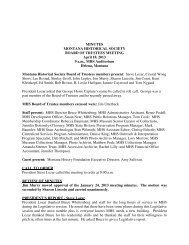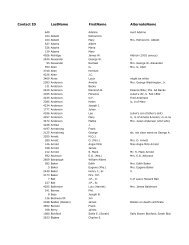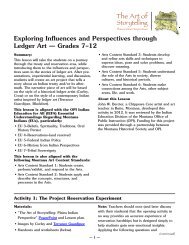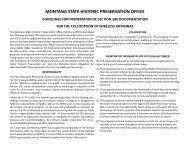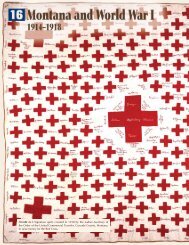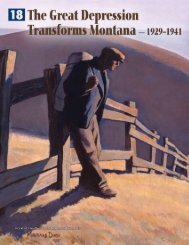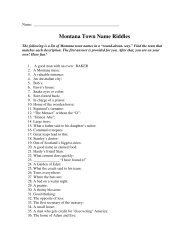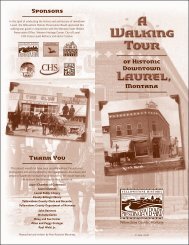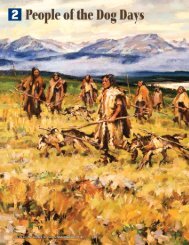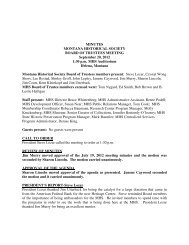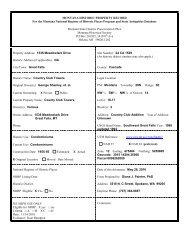Chapter 11 - Montana Historical Society
Chapter 11 - Montana Historical Society
Chapter 11 - Montana Historical Society
Create successful ePaper yourself
Turn your PDF publications into a flip-book with our unique Google optimized e-Paper software.
FIGURE <strong>11</strong>.1: Reservation Scene, by William Standing, ca. 1930<br />
1879<br />
Edison patents<br />
long-lasting<br />
light bulb<br />
1876–77<br />
Great Sioux War<br />
1883<br />
Northern Pacifi c<br />
Railroad completes<br />
transcontinental<br />
route<br />
1881<br />
Sitting Bull surrenders to the U.S. Army<br />
1883<br />
Fewer than 200 bison<br />
208<br />
remain on the Plains<br />
1883–84<br />
Starvation Winter<br />
1895<br />
Blackfeet cede land that<br />
becomes Glacier National Park<br />
1887<br />
Northern reservation<br />
reduced by 17 million acres<br />
1887<br />
Dawes Act<br />
1889<br />
<strong>Montana</strong> becomes a state<br />
1880–1934<br />
Indian boarding school era<br />
1904<br />
Crow cede northern<br />
strip of reservation<br />
1875 1880 1885 1890<br />
1895<br />
1900<br />
19<br />
1887<br />
Great Northern<br />
Railway enters<br />
<strong>Montana</strong><br />
1896<br />
Assiniboine and Gros Ventre<br />
cede part of the<br />
Little Rocky Mountains
05<br />
1908<br />
Model T invented<br />
1910<br />
1908<br />
Winters decision upholds<br />
Indian water rights<br />
1914–18<br />
World War I<br />
1916<br />
Rocky Boy’s Reservation<br />
created for Chippewa-Cree<br />
1923<br />
Federal government kills Crow and<br />
Northern Cheyenne horse herds<br />
ReAd To Find ouT:<br />
n How Indians survived without the bison<br />
n How the U.S. government tried<br />
to destroy Indian culture<br />
n What Indian people did to keep<br />
their cultural traditions alive<br />
n Why non-Indians own so much land<br />
on some Indian reservations<br />
The Big Picture<br />
After the bison were destroyed, <strong>Montana</strong>’s Indians<br />
went through a period of tremendous change.<br />
These were years of great hardship for Indian<br />
people as they learned to live a new way. Their<br />
strength and adaptability helped them survive<br />
and pass on their cultural traditions.<br />
in the late 1800s <strong>Montana</strong>’s Indians entered a period of<br />
tremendous upheaval. The bison—once the center of life here—<br />
teetered on the brink of extinction. The expanding United States<br />
had overwhelmed the tribes’ economic and military power and<br />
confi ned the native people to reservations (land that tribes<br />
reserved for their own use through treaties).<br />
When the Indian tribes were strong, the U.S. government<br />
respected their sovereignty (powers of self-government).<br />
But when they became weak, the government took more control.<br />
Government policies imposed many diffi culties on the Indian<br />
people as they adapted to a new way of life. The story<br />
of this period is one of great suffering—but also of great<br />
perseverance (strength and endurance).<br />
1907–34<br />
Reservations face allotment<br />
1934<br />
Congress passes the<br />
Indian Reorganization Act (IRA)<br />
1915 1920 1925 1930<br />
1935<br />
209<br />
4 — N E W C O M E R S E X P L O R E T H E R E G I O N 2 0 9
FIGURE <strong>11</strong>.2: Confi ned to reservations<br />
and facing an unknown future, families<br />
like this one on the Crow Reservation<br />
wondered what was ahead for their<br />
children.<br />
2 1 0 P A R T 2 : A C E N T U R Y O F T R A N S F O R M A T I O N<br />
The Bison Era Comes to an End<br />
In 1881 Sitting Bull—who had helped lead the Sioux during the Battle of<br />
the Little Bighorn—returned from Canada, where he and his band had<br />
fl ed at the end of the Great Sioux War. Returning to the United States<br />
meant surrendering to the U.S. Army. Sitting Bull did not want to give<br />
up his freedom, but his people were starving. The buffalo were gone.<br />
Even smaller game animals were hard to fi nd.<br />
On the day of his surrender, he gave his eight-year-old son, Crowfoot,<br />
his gun to turn over to the commanding offi cer. Then he said, “The boy<br />
has given it to you, and he now wants to know how he is going to<br />
make a living.”<br />
The question of how to make a living haunted all of <strong>Montana</strong>’s<br />
Indians in the early reservation era.<br />
Starvation Winter: Trading More Land for Food<br />
For most of the 1870s, <strong>Montana</strong>’s tribes continued to live primarily on<br />
the game and plants they harvested, just as their ancestors had for generations.<br />
They depended very little on annuities (annual payments of<br />
food, equipment, supplies, and funds the U.S. government owed a tribe<br />
by treaty).<br />
But by 1880 the bison were nearly gone, the population of settlers had<br />
boomed, and there was little game to hunt. The Blackfeet, Gros Ventre,<br />
Sioux, and Assiniboine—who lived on a large reservation covering much<br />
of northern <strong>Montana</strong>—increasingly depended on government annuities<br />
for survival. These annuities<br />
were not charity; they<br />
were payments for land<br />
(see <strong>Chapter</strong> 7). Yet despite<br />
its treaty agreements,<br />
Congress reduced the<br />
amount of money it was<br />
willing to spend on annuities.<br />
For several years<br />
there was not enough food<br />
to get people through the<br />
winter.<br />
In 1883 winter storms<br />
came early. The few provisions<br />
that the government<br />
did send to the<br />
northern tribes were held<br />
up by early snows. Finally,<br />
in December, a wagonload<br />
of bacon arrived at
Western Indian Lands, 1850–1890<br />
FIGURES <strong>11</strong>.3, <strong>11</strong>.4, and <strong>11</strong>.5:<br />
In 1850 Indian tribes owned<br />
all the lands in the western<br />
United States (shown in blue).<br />
In the next four decades,<br />
Indians ceded (gave up) more<br />
and more land. (Tribal land<br />
east of the Mississippi River<br />
is not shown.)<br />
Western Indian Lands before 1850<br />
Western Indian Lands by 1870<br />
Western Indian Lands by 1890<br />
1 1 — T H E E A R L Y R E S E R V A T I O N Y E A R S 2 1 1
“I Am Given Little Food”<br />
“We old Indians never knew of any way of obtaining<br />
food except by hunting. The government promised to<br />
feed us if we would live on the reservations. But I am<br />
given very little food. Each month our Indian policeman<br />
brings me one quart of green coffee, one quart<br />
of sugar, a few pounds of flour and a small quantity<br />
of baking powder. I am told that I might get more if<br />
I should go each month and ask the agent for it. But<br />
my home is more than 20 miles over a mountain . . .<br />
It should not be expected that a 92-year-old woman<br />
get her food by personally going to the agency every<br />
month on a certain day and during certain hours of<br />
the day . . . It would be hard enough in summer. It is<br />
impossible in winter.”<br />
—IRON TEETH, A NORTHERN CHEYENNE WOMAN<br />
FIGURE <strong>11</strong>.6: Chief Mountain has been<br />
a sacred area to Blackfeet Indians<br />
for hundreds of years. It is part of the<br />
land the tribe sold in 1895. “Chief<br />
Mountain is my head,” said Blackfeet<br />
leader White Calf. “Now my head is<br />
cut off.” American painter John Fery<br />
(1859 –1934) painted this picture of<br />
Chief Mountain around 1915.<br />
2 1 2 P A R T 2 : A C E N T U R Y O F T R A N S F O R M A T I O N<br />
Browning—so old it was contaminated with<br />
maggots.<br />
Approximately one-quarter of the Blackfeet<br />
tribe—600 people—died from starvation. The<br />
Assiniboine lost approximately 300 people.<br />
Many Gros Ventre and Sioux also died from<br />
hunger and exposure. Tribal people call this<br />
period “Starvation Winter.”<br />
After Starvation Winter, the tribes sold<br />
the only resource they had left—land. The<br />
Sweetgrass Hills Agreement of 1888 reduced<br />
the large northern Indian reserve to<br />
three smaller reservations: the Blackfeet, Fort<br />
Belknap, and Fort Peck Reservations.<br />
In 1895 the Blackfeet sold another strip<br />
of land that prospectors hoped would contain<br />
gold. When no gold was found there,<br />
most of this land became Glacier National<br />
Park. The next year the government pressured the Assiniboine and<br />
Gros Ventre to sell a 28-square-mile chunk of the sacred Little Rocky<br />
Mountains. There miners developed a large gold mine.<br />
Life on the Reservations<br />
By 1888 nine Indian tribes—the Blackfeet, Crow, Assiniboine, Gros Ventre,<br />
Sioux, Salish, Kootenai, Pend d’Oreille, and Northern Cheyenne—were<br />
living on six <strong>Montana</strong> reservations. (Rocky Boy’s Reservation—home<br />
to members of the Chippewa and Cree tribes—was not established until<br />
1916. See <strong>Chapter</strong> 15.)<br />
Government policies on<br />
the reservations refl ected<br />
what many non-Indians<br />
thought at the time: that<br />
the best way for Indians to<br />
adjust to a rapidly changing<br />
world was to give up<br />
their tribal traditions and<br />
live like Euro-Americans<br />
(Americans with European<br />
influence or ancestry).<br />
Assimilation (when one<br />
culture is absorbed into another,<br />
majority culture) was<br />
the goal of the reservations.<br />
So while American Indian<br />
tribes struggled to main-
tain their cultural traditions in the face of change, the government’s goal<br />
was to tear apart tribal traditions and replace them with Euro-American<br />
practices.<br />
Secretary of the Interior Columbus Delando made this goal clear in<br />
1872: “It is our duty to coerce (force) . . . [the Indians] into the adoption<br />
and practice of our habits and customs.”<br />
Agents Controlled the Reservations<br />
Each reservation had an agent, appointed by the commissioner of Indian<br />
affairs. The reservation agent managed the tribes’ limited budget and<br />
controlled how the money was spent. He also set the rules for the reservation,<br />
and he could arrest people or withhold food rations if they broke<br />
those rules. The tribes owned the land, yet agents had almost complete<br />
control over life on the reservation.<br />
Some agents worked hard to help the Indians on their reservations.<br />
Peter Ronan, a longtime agent on the Flathead Reservation, for example,<br />
tried to keep the railroad from cutting timber on the reservation and to<br />
keep white farmers from taking Indian land. However, most agents did<br />
not know very much about the Indian people they were supposed to be<br />
helping. Many agents came from far away and stayed for only a short<br />
time. Often they did not have enough knowledge, money, or supplies<br />
to do the job. And some were simply dishonest. They stole money from<br />
the tribes, sold tribal food for their own profi t, or used tribal resources<br />
for their own gain.<br />
On the more established reservations, like the Flathead Reservation,<br />
people had developed farms, ranches, and sawmills over several decades.<br />
Their economic independence gave them power to resist some government<br />
control. But on the<br />
poorest reservations, people<br />
depended on government<br />
annuities. The government<br />
agents could often control<br />
people by withholding food<br />
and supplies.<br />
Forcing a New Way<br />
Even honest agents thought<br />
they were helping Indians<br />
by forcing them to abandon<br />
their traditional cultures<br />
and to adopt mainstream<br />
(majority) American culture.<br />
Agents pressured tribal<br />
members to change their<br />
FIGURE <strong>11</strong>.7: Hunger defi ned life on the<br />
reservations. That may be why these<br />
Blackfeet women are peering into the<br />
government slaughterhouse on beefslaughtering<br />
day in 1887.<br />
1 1 — T H E E A R L Y R E S E R V A T I O N Y E A R S 2 1 3
FIGURE <strong>11</strong>.8: Blackfeet tribal members<br />
listen to a presentation on growing<br />
wheat at the Midwinter Fair in<br />
Browning in the 1920s.<br />
2 1 4 P A R T 2 : A C E N T U R Y O F T R A N S F O R M A T I O N<br />
social customs, dress in European-style clothing, live in rectangular<br />
houses, become Christian, send their children to school, and learn farming<br />
and ranching the Euro-American way.<br />
Agents often outlawed Indian religious ceremonies like the Sun Dance.<br />
They discouraged give-away ceremonies, a traditional practice of honoring<br />
the Creator by giving away food, blankets, horses, and other forms<br />
of wealth. If people performed their traditional practices or religious<br />
rituals, they could lose their food rations or be arrested. They also were<br />
not allowed to leave their reservations without a pass.<br />
The reservation system tore apart tribal leadership. Each tribe had<br />
long-established traditions for earning leadership roles. But reservation<br />
life made it diffi cult for young men to become leaders in the traditional<br />
way because they could not count coup (earn respect by performing<br />
acts of bravery during a battle), host a Sun Dance, or complete other<br />
traditional requirements for leadership. Reservation agents sometimes<br />
selected their own “chiefs” and refused to deal with strong Indian leaders<br />
who disagreed with them.<br />
By removing the Indians’ traditional leadership, the government<br />
made it harder for people to make decisions. Tribal members knew they<br />
needed to make changes to survive. But they did not always agree on<br />
how fast things should change, and in what ways. These disagreements<br />
sometimes caused serious confl icts within the tribes.<br />
For example, on the Blackfeet Reservation, one group pushed for<br />
economic development projects like oil development and irrigation, even
though older, more traditional Blackfeet would not benefi t. Another<br />
group wanted to slow down development to make sure tribal decisions<br />
were made according to traditional values. These arguments split the<br />
Blackfeet tribe. Some of these disagreements continue today.<br />
The People Kept Their Cultures Alive<br />
<strong>Montana</strong>’s Indians knew they needed to learn new skills and fi nd new<br />
ways to support themselves. But they refused to abandon their tribal<br />
identities and cultural traditions to survive.<br />
They performed give-aways and held religious ceremonies in secret.<br />
They turned patriotic and religious holidays—like the Fourth of July and<br />
Easter—into celebrations of their own traditions.<br />
In 1898 the tribes of the Flathead Reservation held their fi rst Fourth of<br />
July pow-wow (an American Indian celebration). They staged parades,<br />
held contests, sang and drummed together, and danced traditional dances<br />
like the War Dance and the Snake Dance deep into the night. Indians on<br />
other reservations also held celebrations on July 4. The organizers assured<br />
the reservation agent that these gatherings were purely social, but they<br />
actually performed important religious and tribal ceremonies.<br />
Federal agents also started county fairs on reservations to show<br />
off Indians’ farming accomplishments. In 1904, for example, the Crow<br />
Reservation agent started the Crow Fair. At the fair, the Crow staged<br />
parades, horse races, and rodeos. They used the fair to reinforce tribal<br />
values and traditions. Today Crow Fair is one of the most popular<br />
summer events in <strong>Montana</strong>.<br />
Diseases Set<br />
Everyone Back<br />
While each reservation was<br />
different, they all struggled<br />
against poverty and disease.<br />
Sudden changes in how<br />
American Indians lived and<br />
what they ate made them especially<br />
vulnerable to illness.<br />
Poor sanitation, crowded<br />
living conditions, and lack<br />
of nutritious food helped<br />
spread contagious diseases.<br />
Tuberculosis (an infectious<br />
lung disease) was<br />
the leading killer of American<br />
Indians in the early reservation<br />
years. Tuberculosis<br />
FIGURE <strong>11</strong>.9: Sometimes adapting<br />
means fi tting a traditional skill to<br />
a new purpose. A Sioux beader<br />
made this elaborately decorated<br />
hide bag to carry ration coupons,<br />
which each Indian family needed<br />
to collect food rations.<br />
FIGURE <strong>11</strong>.10: The Gros Ventre and<br />
Assiniboine of the Fort Belknap<br />
Reservation turned the Fourth of<br />
July in 1904 into an opportunity<br />
to perform important ceremonies.<br />
The family in the foreground is<br />
conducting a give-away.<br />
1 1 — T H E E A R L Y R E S E R V A T I O N Y E A R S 2 1 5
FIGURE <strong>11</strong>.<strong>11</strong>: Northern Cheyenne<br />
farmers Wesley Whiteman (left) and<br />
James Flying Bird (right) grew wheat,<br />
oats, alfalfa, and seven gardens full of<br />
vegetables. Whiteman said later, “I put<br />
the watermelon and cantaloupe on the<br />
side hill and when they got ripe they’d<br />
come off the vine and roll down to a<br />
place where I’d pick them up.”<br />
2 1 6 P A R T 2 : A C E N T U R Y O F T R A N S F O R M A T I O N<br />
sickened one-third of the<br />
entire American Indian<br />
population, and up to<br />
90 percent on some reservations.<br />
Trachoma (a<br />
contagious eye disease that<br />
causes blindness) affected<br />
one in every fi ve American<br />
Indians. Thousands of<br />
non-Indians suffered and<br />
died from these diseases,<br />
too, but they were most<br />
prevalent on Indian<br />
reservations.<br />
Making a Living on the Reservations<br />
Indian people learned Euro-American farming techniques as a way to<br />
make a living after the bison were gone. The Salish, Pend d’Oreille, and<br />
Kootenai people of western <strong>Montana</strong> had been growing vegetables<br />
and wheat since the 1850s. Their hard work, their hand-dug irrigation<br />
system, and the rich, loamy soils of the region helped the people of the<br />
Flathead Reservation make headway against the grinding poverty that<br />
reservation life usually brought.<br />
The Northern Cheyenne people had begun farming and timber cutting<br />
in the 1880s, even before they had a reservation. The Crow people, too,<br />
gained some successes in farming. Far back in Crow history—before the<br />
Crow people came to the Plains—they had been agriculturalists. Perhaps<br />
this helped them become successful farmers during this period.<br />
Some reservation farmers struggled to build farms and learn how to<br />
operate unfamiliar equipment. Often the government did not send adequate<br />
equipment and funding, as promised in the treaties. On the Flathead<br />
Reservation, there were not enough plows to work the 80 fi elds of wheat.<br />
Reservation agent John Mullan reported that one old Salish man “planted<br />
a considerable crop this year, literally scratching it in with his nails.”<br />
Water and the Winters Decision<br />
While Indians were building their farms, their non-Indian neighbors<br />
were also building farms and ranches. Non-Indians often grazed their<br />
cattle on reservation lands and diverted water from rivers and streams<br />
to irrigate their farms. On the Fort Belknap Reservation, an argument<br />
over water turned into a landmark (historically important) court decision<br />
establishing water rights for Indian tribes.<br />
In 1905 the Fort Belknap Reservation agent, William R. Logan, complained<br />
to the commissioner of Indian affairs that nearby farmers were
diverting water from the Milk<br />
River before it could fl ow<br />
through the reservation. “So<br />
far this spring, we have had no<br />
water in our ditch whatever,”<br />
he wrote. “All will be lost unless<br />
some radical action is taken . . .<br />
To the Indians it means either<br />
good crops this fall or starvation<br />
this winter.”<br />
The argument over water<br />
rights went all the way to<br />
the U.S. Supreme Court. The<br />
court’s ruling became known<br />
as the Winters decision (after<br />
one of the people involved in<br />
the case). The Winters decision<br />
upheld the Indians’ rights<br />
to the water based on treaty<br />
agreements. This victory gave<br />
Indian tribes all over the United States a vital tool in their struggle to<br />
survive and to remain on their land.<br />
Ranching on the Reservations<br />
Many tribal members embraced ranching. Cattle ranching and horse raising<br />
allowed them to support their families while practicing time-honored<br />
cultural values like feeding relatives and giving away cattle and horses.<br />
Reservation ranchers formed cattlemen’s associations based on family<br />
groups and clans, which helped strengthen traditional social structures.<br />
Ranching on the reservation sometimes confl icted with traditional<br />
tribal values. Reservation agents pressured ranchers to work for profi t,<br />
save money, buy more equipment, and become more successful. But<br />
tribal tradition encouraged everyone to work for the good of the tribe<br />
and help anyone in need.<br />
On the Blackfeet Reservation, some ranchers sold off their cattle during<br />
hard winters to help feed hungry relatives. But when they did not show a<br />
profi t, the reservation agent labeled them “incompetent” and did not allow<br />
them any more opportunities. Each tribe and family struggled to fi nd a<br />
balance between tribal traditions and new defi nitions of success.<br />
The Government Kills Off Crow and Cheyenne Herds<br />
Indian agents were supposed to encourage Indian ranchers to work<br />
for their own gain. But in 1914 the agent on the Northern Cheyenne<br />
Reservation confi scated (took) 20,000 to 30,000 cattle owned by<br />
FIGURE <strong>11</strong>.12: The Fort Belknap tribes<br />
built this dam across the Milk River to<br />
supply water to reservation farmlands.<br />
But upriver settlers took so much water<br />
that there was not enough left for<br />
the reservation. Ultimately, the U.S.<br />
Supreme Court upheld the tribes’<br />
water rights.<br />
1 1 — T H E E A R L Y R E S E R V A T I O N Y E A R S 2 1 7
“<br />
There were dead horses everywhere.<br />
It was a horrible smell. To add insult<br />
to injury, they came from Billings<br />
with wagons and loaded the bones<br />
of our brothers, the horses, to take<br />
them for fertilizer. They said they<br />
killed 44,000 horses, but it was way<br />
more than that.<br />
”<br />
—JOE MEDICINE CROW, CROW HISTORIAN<br />
FIGURE <strong>11</strong>.13: The relationship between<br />
Plains Indians and their horses ran<br />
deep and strong. Here, John Stands<br />
in Timber Jr., a Northern Cheyenne,<br />
stands with his horse.<br />
2 1 8 P A R T 2 : A C E N T U R Y O F T R A N S F O R M A T I O N<br />
individual Northern Cheyenne ranchers. These<br />
Cheyenne ranchers had established a reputation for<br />
high-quality cattle. When the agent took their cattle,<br />
they lost everything they had worked for.<br />
Agency (reservation headquarters) offi cials<br />
began managing the herd for reservation use. But<br />
they failed to provide winter feed and left the cattle<br />
on the summer grounds through midwinter.<br />
Within a few years there were only 4,000 cattle<br />
left. The reservation agent sold them off, and the<br />
government opened the reservation to grazing for<br />
white cattlemen. The Northern Cheyenne people once again plunged<br />
into poverty.<br />
Dr. Richard Littlebear, a Northern Cheyenne educator and college<br />
president, said his grandfather had been a relatively successful rancher<br />
before 1914. “He owned livestock, had built a house, and was providing<br />
well for his family,” Littlebear said. “After the government took his<br />
livestock away . . . all incentive seemed to desert him. This happened to<br />
many Northern Cheyenne families.”<br />
The pressure by non-Indians to spread onto reservation lands continued.<br />
In 1919 the government ordered the Crow and Northern Cheyenne<br />
tribes to reduce the number of horses on the reservation. The horses ate<br />
grass that white ranchers wanted for their cattle. These ranchers paid the<br />
agents for grazing rights on the reservations.<br />
The government wanted the horses killed because the herds did not<br />
have economic value. The tribes<br />
refused. As historian Joe Medicine<br />
Crow wrote, it “was like ordering<br />
a man to kill his best friend or<br />
brother.”<br />
In 1923 the government contracted<br />
with non-Indian cattlemen<br />
to shoot thousands of horses on<br />
the Crow and Northern Cheyenne<br />
Reservations. “One large outfi t had<br />
to import Texas gunmen to do the<br />
shooting, as local cowboys were<br />
soon disgusted with the slaughter,”<br />
wrote Medicine Crow.<br />
Other Reservation Industries<br />
The Flathead, Crow, and Northern<br />
Cheyenne Reservations all had<br />
timber abundant enough to support<br />
commercial sawmills. At fi rst
government employees, not tribal members, ran the mills and used the<br />
lumber. Indian people did not get to cut and sell timber.<br />
After 1900 the Indian tribes regained some control over their forestlands.<br />
Forestry and lumber milling became an important part of<br />
the tribal economy on the Flathead, Crow, and Northern Cheyenne<br />
Reservations.<br />
Each tribe worked to develop the resources it had. For example, the<br />
Blackfeet tribe tried to gain some economic benefi t from oil. The tribe<br />
itself lacked the funds to invest in oil equipment and the expertise to drill<br />
for oil. Instead, it leased its oil resources to non-Indian developers. But<br />
the federal government discouraged oil leases on the reservations and<br />
sometimes failed to enforce the terms of the leases they had agreed to.<br />
So the tribe received only a few thousand dollars from several small oil<br />
leases during the 1920s.<br />
The Dawes Act:<br />
Allotments Subdivide the Reservations<br />
One purpose of the reservations was to turn Indians into farmers. This<br />
was part of Thomas Jefferson’s view of America as a nation of small<br />
farmers who owned their own land (see <strong>Chapter</strong> 4).<br />
In the 1880s concerned non-Indians worried that American Indians<br />
were not becoming farmers fast enough. Some wanted to help Indians<br />
expand their economies and attract businesses onto their reservations.<br />
At the same time, <strong>Montana</strong> ranchers and farmers continually<br />
pressured the government to open up more<br />
reservation land for farms and cattle grazing.<br />
As a result of these various pressures, Congress passed<br />
the Dawes Act of 1887 (also called the General Allotment<br />
Act). The act was named after its sponsor, U.S. senator Henry<br />
Dawes of Massachusetts. The Dawes Act is one of the most<br />
important and controversial laws in American Indian history.<br />
Its effects are still felt today (see <strong>Chapter</strong> 22).<br />
The Dawes Act had several goals: to break up tribes<br />
as economic units, to encourage individual initiative, to<br />
reduce the government’s costs of running the reservations,<br />
and to provide more land to white settlers. Supporters<br />
thought the Dawes Act would help destroy tribes, which<br />
they saw as obstacles to assimilation.<br />
The Dawes Act provided for reservation lands to be<br />
allotted (divided up) into individual parcels about the<br />
size of a small family farm. Heads of households were<br />
typically assigned 160 acres. Unmarried tribal members<br />
over age 18 usually received 80 acres. (Married women<br />
could not receive allotments until after 1891.)<br />
FIGURE <strong>11</strong>.14: Many American Indians<br />
expanded their economic opportunities<br />
by making crafts to sell to tourists at<br />
<strong>Montana</strong>’s national parks. Yellowstone<br />
National Park gift shops sold Indianmade<br />
parfl eche (rawhide) wastebaskets<br />
like this one, as well as hand-beaded<br />
purses and picture frames.<br />
FIGURE <strong>11</strong>.15: Oil discoveries in northern<br />
<strong>Montana</strong> made companies very<br />
interested in drilling for oil on Blackfeet<br />
land. These two people are watching<br />
the tank fi ll up with the fi rst commercial<br />
production of oil from an oil lease<br />
site on the Blackfeet Reservation.<br />
1 1 — T H E E A R L Y R E S E R V A T I O N Y E A R S 2 1 9
“<br />
It has become the settled policy of the<br />
Government to break up reservations,<br />
destroy tribal relations, settle Indians<br />
upon their own homesteads, incorporate<br />
them into the national life, and<br />
deal with them not as nations or tribes<br />
or bands, but as individual citizens.<br />
”<br />
—COMMISSIONER OF INDIAN AFFAIRS THOMAS J. MORGAN, 1890<br />
FIGURE <strong>11</strong>.16: This poster, issued by the<br />
U.S. secretary of the interior in 1910,<br />
offered Indian lands to farmers and<br />
speculators at low prices. In <strong>Montana</strong><br />
the government offered <strong>11</strong>,034 acres at<br />
$9.86 per acre—about $216 today.<br />
2 2 0 P A R T 2 : A C E N T U R Y O F T R A N S F O R M A T I O N<br />
Once land was allotted, it was owned by an<br />
individual, not by the tribe. Allotted lands were<br />
held in trust (when something is owned by one<br />
person but managed by another—in this case,<br />
the government) for 25 years. After that, they<br />
could be sold.<br />
The land that was not allotted to Indian<br />
individuals or families could be declared surplus—extra.<br />
Often these surplus lands were sold<br />
to white settlers, businesses, and homesteaders at<br />
discount prices.<br />
The Dawes Act affected each reservation differently. Allotments came<br />
to the Crow Reservation fi rst, starting in 1888. But it took many years to<br />
complete the allotment process, and before it was fi nished, Crow leaders<br />
fought for— and won —the right to determine how the process would<br />
work. After allotments were completed in the early 1920s, most of the<br />
land remained in the hands of tribal members. Determined and skillful<br />
Crow negotiators kept land from being<br />
sold to non-Indians as “surplus” land.<br />
Allotments began on the Blackfeet<br />
Reservation in 1907. The government<br />
designated 156,000 acres as surplus. The<br />
Blackfeet tribe was $1 million in debt after<br />
following federal instructions to build a<br />
large irrigation system. To pay off this<br />
debt, the government wanted to sell off<br />
the surplus land as quickly as possible.<br />
But the Blackfeet protested the land<br />
sale. An educated Blackfeet spokesman<br />
named Robert Hamilton testifi ed repeatedly<br />
before congressional committees and<br />
with the federal Offi ce of Indian Affairs.<br />
Finally, in 1919, Congress accepted a<br />
compromise. Surplus Blackfeet land<br />
was added to individual allotments and<br />
remained in Blackfeet hands.<br />
The Fort Peck Reservation was allotted<br />
between 1908 and 1913. This was the<br />
height of the homestead boom (see <strong>Chapter</strong><br />
13). Each adult male received 320 acres<br />
plus a few acres of farm and timber lands.<br />
After allotments were completed, the government<br />
declared 1.3 million acres surplus<br />
and open to homesteaders. Today most of<br />
the best agricultural land on the Fort Peck<br />
Reservation is owned by non-Indians.
Allotments came to the Flathead Reservation in 1908—despite strong<br />
protests from the tribes who lived there. After allotments, the government<br />
intended to declare the rest of the reservation surplus and open<br />
it for sale. Salish chief Charlot, who had defended his people’s right to<br />
remain in the Bitterroot Valley in the 1880s, protested any further loss<br />
of tribal lands. He already had told the government, in 1901, “I won’t<br />
sell a foot!”<br />
The government delayed until Chief Charlot died, in 1910. Two weeks<br />
after Charlot’s death, the government announced that it would open<br />
1 million acres of the reservation for sale to homesteaders. More than<br />
two-thirds of the Flathead Reservation lands—including most of the<br />
fertile Mission Valley—transferred out of tribal hands (see the maps in<br />
<strong>Chapter</strong> 13).<br />
On the Fort Belknap Reservation, tribal leaders saw allotments as a<br />
way to preserve the land they had left. Large tracts of their reservation<br />
lands had been illegally sold off. They had also lost a large chunk of<br />
the Little Rockies, when the government forced the tribes to sell it for a<br />
gold-mining operation in 1896. Profi ts from these land sales never made<br />
it into tribal hands.<br />
Scared that the government would take even more of their land, the<br />
Fort Belknap tribes lobbied to have the reservation allotted. They successfully<br />
insisted that all the land go to tribal members. Their reservation<br />
was allotted in 1923.<br />
The Northern Cheyennes also fought to preserve their reservation<br />
lands. They were able to postpone allotments until 1932–34, and the<br />
tribe managed to retain ownership of most of its land.<br />
FIGURE <strong>11</strong>.17: Salish farmers, like<br />
the one shown here driving a<br />
McCormick harvester outfi t, were<br />
as prosperous as local non-Indian<br />
farmers before allotments.<br />
1 1 — T H E E A R L Y R E S E R V A T I O N Y E A R S 2 2 1
FIGURE <strong>11</strong>.18: Crow Indian policemen<br />
were paid $6 ($140 today) for each<br />
child they delivered to school. A Crow<br />
boy attending Carlisle Indian Industrial<br />
School in Pennsylvania drew this picture<br />
of reservation agent Major Wyman<br />
and a tribal policeman collecting a<br />
little Crow girl from her mother.<br />
The Results of Allotment<br />
2 2 2 P A R T 2 : A C E N T U R Y O F T R A N S F O R M A T I O N<br />
Think about what it would be like if someone came into your home,<br />
confi ned you to the room you happened to be standing in, and sold the<br />
rest of the house because you were not using it. For many Indian people,<br />
this is what allotment was like.<br />
Together <strong>Montana</strong>’s reservations lost more than 400,000 acres of<br />
land—in some cases the only farmable land on the reservation—to non-<br />
Indian ownership. Before allotments, tribal members on the Flathead<br />
Reservation were about as well-off as non-Indian farmers. But losing<br />
access to farmland, grazing land, and other important resources drove<br />
many of them into poverty.<br />
On the Blackfeet, Crow, and Flathead Reservations, the government<br />
had urged tribes to spend large amounts of money to build irrigation<br />
projects. But those irrigation projects ended up mostly helping the non-<br />
Indian farmers who moved onto the reservations—not the Indians who<br />
paid for the improvements.<br />
Allotments also changed how land was used on reservations. It forced<br />
some tribal members to sell off large horse and cattle herds that could no<br />
longer graze on communal (shared by all members of a community)<br />
reservation lands. Where it was too dry to farm, Indian landowners often<br />
sold their allotments just to pay their taxes or buy food. The Blackfeet, for<br />
example, lost 200,000 acres between 1912 and 1929. Most of the land went<br />
to local businesses to pay debts for items purchased at their stores.<br />
In the 47 years that allotments were in effect, tribes across the West<br />
lost 70 percent of their remaining lands. Years later John Collier, the<br />
U.S. commissioner of Indian affairs,<br />
wrote that allotments had caused<br />
“poverty bordering on starvation<br />
in many areas, a 30 percent illiteracy<br />
rate (percentage of people<br />
who cannot read), a death rate<br />
twice that of the white population,<br />
and the loss of more than 90 million<br />
acres of Indian land.”<br />
Losing Our Selves:<br />
The Boarding School<br />
Experience<br />
Imagine being rounded up by foreigners,<br />
taken from your parents,<br />
and sent to a strange institution far<br />
away from home. Your clothes are<br />
burned. Your hair is cut off—something<br />
that usually happens when
a family member dies. You are punished for<br />
speaking your own language. You are given a<br />
new, unfamiliar name and made to answer to it.<br />
People you do not know force you to eat, sleep,<br />
talk, and work in a way that is strange to you.<br />
No matter how homesick you get, you may not<br />
see your parents again for many years.<br />
Many Americans thought that the fastest<br />
way to help Indian people assimilate (be<br />
absorbed into the majority culture) was to<br />
remove Indian children from their families<br />
and bring them up as<br />
“<br />
“<br />
I attended the Fort Belknap Boarding<br />
School when I was fi ve years old . . . The<br />
little ones, I saw them clinging to their<br />
mothers and they were just crying. They<br />
didn’t want to leave home. The police<br />
went after them to go to school. I have<br />
seen the police just pull the kids away<br />
from their mother’s arms.<br />
”<br />
—VERNIE PERRY, ASSINIBOINE, FORT BELKNAP<br />
white children. So thousands<br />
of Indian children The Indians do not take kindly to these schools. It has<br />
were sent to boarding been necessary to use force to get pupils and keep<br />
schools. Reservation agents them in school. It is one of those cases, however,<br />
forced parents to surrender where force must be added to persuasion and reason<br />
their children so they could<br />
to have the Indians do what is best for themselves.<br />
”<br />
be sent to school. Sometimes<br />
—J. W. WATSON, CROW RESERVATION AGENT, IN 1894<br />
families lost their food rations<br />
for not cooperating.<br />
Most of <strong>Montana</strong>’s Indians favored education. They wanted their<br />
children to learn new skills and professions. But they did not want their<br />
children taken away from them. And they did not want their children<br />
to lose respect for tribal traditions.<br />
Many children went to boarding schools on the reservations. Often<br />
their parents would camp near the schools, hoping to see their children.<br />
Some educators believed that students would assimilate faster if<br />
they were removed from the reservations entirely. After 1890 several<br />
thousand of <strong>Montana</strong>’s Indian children were sent far away: to the<br />
Carlisle Indian Industrial School in Pennsylvania, the Haskell Indian<br />
School in Kansas, or the Chemawa Indian School in Oregon. Most of<br />
these students did not return home for many years.<br />
The goal of the schools was to erase the children’s memories of<br />
their native language and culture and to reshape them as non-Indians.<br />
Students studied half the day and worked the other half in laundries,<br />
kitchens, leather shops, and dairies. They learned English, math, and<br />
how to structure their day by the clock. A retired military offi cer oversaw<br />
the Carlisle school, which he ran like a military unit. Students wore<br />
uniforms, marched in military formation, and submitted to disciplines<br />
like beatings and imprisonment in solitary cells.<br />
Many of the schools were overcrowded, which meant that diseases<br />
like tuberculosis spread quickly. Some playgrounds were dotted with<br />
gravestones of the children who died at school.<br />
Many children tried to run away—especially from boarding schools<br />
that were on the reservations. Tribal police were paid to bring them<br />
1 1 — T H E E A R L Y R E S E R V A T I O N Y E A R S 2 2 3
“<br />
Our belongings were taken from us,<br />
even the little medicine bags our mothers<br />
had given us to protect us from harm.<br />
Everything was placed in a heap and set<br />
afi re. Next was the long hair, the pride<br />
of all the Indians. The boys, one by one,<br />
would break down and cry when they<br />
saw their braids thrown on the fl oor.”<br />
—LONE WOLF, A BLACKFEET CHILD WHO WAS SENT TO<br />
CARLISLE INDIAN INDUSTRIAL SCHOOL<br />
FIGURE <strong>11</strong>.19: Girls at the Fort Shaw<br />
Indian School (a former military fort<br />
southwest of Great Falls) learned<br />
sewing, embroidery, knitting, and<br />
other household skills so they could<br />
take domestic jobs when they were<br />
fi nished with school.<br />
2 2 4 P A R T 2 : A C E N T U R Y O F T R A N S F O R M A T I O N<br />
back. Reservation schools usually allowed<br />
parents to see their children for short vacations.<br />
But students at the faraway schools<br />
were sent to white families to work during<br />
school vacations.<br />
Educated Indians Helped Their Tribes<br />
Even though boarding schools caused much<br />
pain and heartache, they also taught Indian<br />
children new skills. Educated Indians returned<br />
home with job skills and knowledge that<br />
helped them improve life on the reservations.<br />
Crow chief Plenty Coups knew how important it was for the tribe<br />
to have young, educated Indians who knew how to speak, write, and<br />
negotiate with white lawyers and politicians. As young educated men returned<br />
from off-reservation boarding schools, he put them to work making<br />
sure the government fulfi lled its treaty obligations. Some, like Robert<br />
Yellowtail, negotiated with Congress and became activist leaders.<br />
One powerful example happened in 1898. A government delegation<br />
pressured the Crow tribe to give up more land for railroads and homesteads.<br />
Plenty Coups told the delegation that the government already<br />
was behind on payments already promised. “When you have made<br />
these settlements to the Indians, then you can come back and I and my<br />
people will talk to you about these lands you now want,” he said.<br />
Then Plenty Coups introduced a group of young men just back from<br />
government schools. One of them, Carl Leider, stepped up and read an<br />
itemized list of the payments the government had promised—and failed—<br />
to make. Leider stunned<br />
the commissioners. They<br />
left, promising to postpone<br />
discussions until<br />
payments could be made.<br />
Blackfeet leader Robert<br />
Hamilton stood up for<br />
the rights of traditional<br />
full-blood Blackfeet people<br />
against a group of<br />
mixed-blood Blackfeet<br />
businessmen who wanted<br />
to control most of the<br />
tribe’s resources. The<br />
government listened to<br />
the businessmen because<br />
they supported economic<br />
development programs.
But Hamilton spoke for the traditional<br />
families who lived in desperate<br />
poverty because of federal<br />
programs. Hamilton had graduated<br />
from Carlisle Indian Industrial<br />
School, and his knowledge and<br />
eloquence (ability to speak convincingly)<br />
made Congress listen.<br />
His leadership kept the tribe from<br />
losing power, money, and much of<br />
its land base.<br />
The boarding school era lasted from 1880 to 1934. During that time,<br />
family ties broke apart. Several generations of Indian children grew<br />
up far from the love and guidance of parents, family, and community.<br />
When they had children of their own, they had no role models for<br />
parenthood. Many American Indian families still struggle with the aftereffects<br />
of the boarding school era.<br />
Yet many children found ways to survive and maintain their cultural<br />
identity. They forged intertribal (between tribes) friendships that later<br />
“<br />
A year before I was sent away [to school] my<br />
grandfather died. When he died he called me<br />
to his death bed. He said, ‘I want you to promise<br />
me that you will become educated and that<br />
you will be the fi rst one to go ahead and do this<br />
for all the family.’ He put a lot on my shoulders,<br />
and I told him I would.<br />
”<br />
—MINERVA ALLEN, CHIPPEWA, ASSINIBOINE, AND GROS VENTRE EDUCATOR FROM FORT BELKNAP<br />
FIGURE <strong>11</strong>.20: These 12 graduates at<br />
the Carlisle Indian Industrial School<br />
in 1892 were from seven different<br />
tribes. Many Indian students befriended<br />
and married members of<br />
other tribes, establishing intertribal<br />
connections that helped American<br />
Indians gain political power.<br />
1 1 — T H E E A R L Y R E S E R V A T I O N Y E A R S 2 2 5
FIGURE <strong>11</strong>.21: This<br />
beaded bag, created<br />
about 1940, expresses<br />
its creator’s devotion<br />
to traditional beading<br />
skills—and her<br />
exposure to things her<br />
great-grandparents<br />
never saw.<br />
FIGURE <strong>11</strong>.22: Despite many obstacles,<br />
American Indians preserved and passed<br />
on their Indian identity and culture<br />
while they struggled to adjust to<br />
enormous changes in their world.<br />
2 2 6 P A R T 2 : A C E N T U R Y O F T R A N S F O R M A T I O N<br />
empowered American Indians to work together for political and cultural<br />
changes. Many returned home to help their tribes. Their creativity and<br />
resilience (ability to withstand great stress) helped them to use what<br />
they learned about mainstream American law and politics to begin making<br />
changes.<br />
People of Strength and Power Endure<br />
The native people of the Northern Rocky Mountains had endured a<br />
century of transformation. Throughout the 1800s they saw a new population<br />
sweep across their lands. They suffered terribly from disease. And<br />
they lost the bison, the primary resource upon which their cultures<br />
depended.<br />
At the end of the 1800s, many non-Indians assumed that Indian tribes<br />
would soon disappear. Disease, loss of land, and attempts to destroy<br />
American Indian cultures did much damage. Nevertheless, <strong>Montana</strong>’s<br />
Indian people managed to adapt. Not only did they survive, but they<br />
also preserved important aspects of their cultures.<br />
Today the number of tribal members is growing. As Blackfeet Tribal<br />
Council chairman Earl Old Person put it, “Our ability to adapt to the environment<br />
and to change is infi nite and assures our survival. The struggles<br />
Indian people went through to survive . . . have made us stronger and it<br />
is through this experience that we can conquer the obstacles ahead.”
Expressions of the People<br />
Star Quilts<br />
In the late 1800s some church women in the Dakotas began<br />
teaching quilting to Sioux women on the reservations. The<br />
Sioux women particularly liked one quilt pattern called the<br />
star quilt. They associated the star quilt pattern with the<br />
sacred circle and the morning star—two powerful images<br />
in Northern Plains cultures.<br />
The Sioux adapted the craft of quilt making to their<br />
own traditions. They began developing their own star quilt<br />
designs using what scraps of fabric were available. They<br />
cut templates (patterns) for their quilt<br />
pieces out of tin or wood, and later<br />
cardboard or plastic oatmeal lids. They<br />
stitched important cultural symbols<br />
into their patterns. And they passed<br />
on their skills and knowledge to the<br />
younger women.<br />
Star quilting quickly spread across<br />
the Fort Peck Reservation. Each quilter<br />
learned the craft from her teacher—<br />
usually an aunt, grandmother, or close<br />
friend. But she had to develop her<br />
own creative ideas for pattern, color,<br />
and use of images or decorative items.<br />
A star quilter occasionally sold her<br />
work, but most quilts were made to<br />
give away. Women made quilts for<br />
marriages, births, and coming-of-age<br />
ceremonies. They gave them to soldiers<br />
leaving for war and to young<br />
men embarking on spiritual quests.<br />
FIGURE <strong>11</strong>.23: This star quilt, made<br />
by Almira Jackson of the Fort Peck<br />
Reservation, is based on early Euro-<br />
American quilting traditions. Yet the<br />
quilter used her own design ideas to<br />
celebrate things important to her tribe:<br />
the morning star, the sacred circle,<br />
and the Indian tipi.
FIGURE <strong>11</strong>.24: Creative use of stitching, fabrics, and ribbon make this<br />
red satin, war bonnet star quilt unique. It was made on the Fort Peck<br />
Reservation (maker unknown) and was presented to Governor Marc<br />
Racicot in the 1990s.<br />
And when a person died, a star quilt<br />
might drape the coffi n, wrap the<br />
body, or hang on the wall during<br />
the funeral.<br />
Over the years the star quilt has<br />
become a vital part of Northern Plains<br />
Indian culture. Because of their<br />
beauty and diffi culty, star quilts<br />
became the center of give-away<br />
ceremonies. Each quilt represents<br />
many days of detailed work. The<br />
Sioux and Assiniboine gain honor<br />
by giving away something of such<br />
value and traditional importance.<br />
Star quilts blend contemporary<br />
artistry with ancient traditions. By<br />
adopting a Euro-American art form<br />
and making it their own, star quilters<br />
have enriched Sioux and Assiniboine<br />
culture with creativity and vigor.<br />
FIGURE <strong>11</strong>.25: Star quilts are often made to give away. This give-away took place in Poplar in 1934.
CHeCK FoR undeRSTAndinG<br />
1. Identify: (a) Carl Leider; (b) Robert Hamilton<br />
2. Defi ne: (a) sovereignty; (b) annuities;<br />
(c) assimilation; (d) count coup; (e) pow-wow<br />
3. What was the Starvation Winter?<br />
4. Describe the job of an Indian agent. List some<br />
of the problems with this system.<br />
5. How did the U.S. government try to undermine<br />
Indian culture? What did Indian people do to<br />
keep their cultural traditions alive?<br />
6. List some of the challenges tribal members<br />
encountered when they started farming and<br />
ranching.<br />
7. What is the Winters decision?<br />
8. What industries besides agriculture did tribal<br />
nations work to develop on their reservations?<br />
9. What is the Dawes Act?<br />
10.<br />
<strong>11</strong>.<br />
12.<br />
13.<br />
14.<br />
15.<br />
What does holding land “in trust” mean?<br />
Which tribes lost the most land under the<br />
allotment policy? Which tribes lost the least?<br />
How did allotments change land use?<br />
Why were Indian children sent to boarding<br />
schools?<br />
What was life like at most boarding schools?<br />
How did tribal members use their boarding<br />
school education to serve their tribes?<br />
CRiTiCAL THinKinG<br />
1. When Sitting Bull’s son gave the leader’s gun to<br />
the U.S. Army, Sitting Bull said, “The boy has<br />
given it [the gun] to you, and he now wants to<br />
know how he is going to make a living.”<br />
What do you think he meant by this?<br />
2. How did (and do) traditional tribal values (like<br />
sharing, working for the good of the tribe, and<br />
preserving the land) sometimes make it hard<br />
for an individual to become rich? What factors<br />
would infl uence your decision if you were<br />
forced to choose between traditional values<br />
and economic success?<br />
3. Look at the photograph on page 214 of the<br />
Midwinter Fair. How do you think the Blackfeet<br />
in this photo might have felt about an outsider<br />
telling them how to use the land they had lived<br />
on for centuries?<br />
4. Philosopher Albert Camus wrote, “The evil that is<br />
in the world almost always comes of ignorance,<br />
and good intentions may do as much harm as<br />
malevolence [wickedness].” Apply this quotation<br />
to the allotment and boarding school eras.<br />
CHAPTeR <strong>11</strong> ReVieW<br />
5. What are some of the legacies of the Indian<br />
boarding school era? Are there both positive<br />
and negative long-term effects?<br />
PAST To PReSenT<br />
1. One legacy of the boarding school era is the<br />
loss of tribal languages. Research current efforts<br />
on many <strong>Montana</strong> reservations to revive native<br />
languages. Do you think preserving Indian<br />
languages is important? Why or why not?<br />
2. How is Indian culture taught at school today?<br />
How is it recognized more broadly in your<br />
community? How do you think it should be<br />
taught and recognized?<br />
MAKe iT LoCAL<br />
1. How did the history outlined in this chapter<br />
affect the families (both Indian and non-<br />
Indian) who live on the reservation closest<br />
to you?<br />
eXTenSion ACTiViTieS<br />
1. Create a Venn diagram to compare Plains<br />
Indian lifestyles in 1800 and Indian life on<br />
the reservations in 1900. Think about the<br />
housing, clothing, food, and daily activities<br />
of Indians during both eras. Then write a<br />
paragraph describing your fi ndings.<br />
2. Make a map of <strong>Montana</strong> showing the<br />
progression of the size and number of Indian<br />
reservations. Use different colors or patterns<br />
to illustrate how the reservation borders<br />
changed over time.<br />
3. Read some fi rst-person accounts and other<br />
narratives about life at Indian boarding<br />
schools. Then write a historical report, create<br />
a play, write a short story, or make a poster<br />
describing what that life was like.<br />
4. Design a star quilt.<br />
5. Create a bar graph comparing the percentage<br />
of Indian-owned land to the total percentage<br />
of land on each reservation as of 2005.<br />
1 1 — T H E E A R L Y R E S E R V A T I O N Y E A R S 2 2 9
Credits<br />
The following abbreviations are used in the credits:<br />
BBHC Buffalo Bill <strong>Historical</strong> Center, Cody, Wyoming<br />
GNPA Glacier National Park Archives<br />
LOC Library of Congress<br />
MAC <strong>Montana</strong> Arts Council, Helena<br />
MDEQ <strong>Montana</strong> Department of Environmental Quality, Helena<br />
MDT <strong>Montana</strong> Department of Transportation, Helena<br />
MFWP <strong>Montana</strong> Fish, Wildlife and Parks, Helena<br />
MHS <strong>Montana</strong> <strong>Historical</strong> <strong>Society</strong>, Helena<br />
MHSA <strong>Montana</strong> <strong>Historical</strong> <strong>Society</strong> Archives, Helena<br />
MHSL <strong>Montana</strong> <strong>Historical</strong> <strong>Society</strong> Library, Helena<br />
MHS Mus. <strong>Montana</strong> <strong>Historical</strong> <strong>Society</strong> Museum, Helena<br />
MHS PA <strong>Montana</strong> <strong>Historical</strong> <strong>Society</strong> Photograph Archives, Helena<br />
MSU COT <strong>Montana</strong> State University College of Technology, Billings<br />
NMAI National Museum American Indian, Smithsonian Institution,<br />
Washington, D.C.<br />
MSU Billings Special Collections, <strong>Montana</strong> State University<br />
Billings Library<br />
NARA National Archives and Records Administration<br />
NPS National Park Service<br />
NRIS Natural Resource Information System, <strong>Montana</strong> State<br />
Library, Helena<br />
SHPO State Historic Preservation Offi ce, <strong>Montana</strong> <strong>Historical</strong><br />
<strong>Society</strong>, Helena<br />
TM Travel <strong>Montana</strong>, Helena<br />
UM Missoula Archives & Special Collections, The University<br />
of <strong>Montana</strong>-Missoula<br />
USDA United States Department of Agriculture<br />
USFS United States Forest Service<br />
WMM World Museum of Mining, Butte<br />
<strong>Chapter</strong> <strong>11</strong><br />
fig. <strong>11</strong>.1 Reservation Scene, William Standing, MHS Mus.<br />
fig. <strong>11</strong>.2 Crow Indians, 1888, photo by O. S. Goff, Fort Custer, MT,<br />
MHS PA 955-809<br />
fig. <strong>11</strong>.3 Western Indian Lands before 1850, map by MHS,<br />
based on information from maps.com<br />
fig. <strong>11</strong>.4 Western Indian Lands by 1870, map by MHS, based on<br />
information from maps.com<br />
fig. <strong>11</strong>.5 Western Indian Lands by 1890, map by MHS, based on<br />
information from maps.com<br />
fig. <strong>11</strong>.6 Chief Mountain, by John Fery, courtesy BNSF Railway<br />
Company, Fort Worth, Texas<br />
fig. <strong>11</strong>.7 Indians Agency on Badger Creek, 1887, MHS PA 955-537<br />
fig. <strong>11</strong>.8 Midwinter Fair, Browning, MT, 1920s, MHS PA 955-532<br />
fig. <strong>11</strong>.9 Beaded hide bag for ration cards, MHS Mus. X1976.08.27<br />
fig. <strong>11</strong>.10 Ft. Belknap give-away, photo by S. W. Matteson,<br />
Milwaukee Public Museum<br />
fig. <strong>11</strong>.<strong>11</strong> Two Northern Cheyenne farmers, BBHC, Thomas Marquis<br />
Collection, PN.165.2.55<br />
fig. <strong>11</strong>.12 Dam across Milk River, Ft. Belknap, MT, MHS PA 955-363<br />
fig. <strong>11</strong>.13 John Stands in Timber Jr., BBHC, Thomas Marquis<br />
Collection, PN.165.2.70<br />
fig. <strong>11</strong>.14 Parfl eche wastebasket, MHS Mus. X1978.46.194<br />
fig. <strong>11</strong>.15 Oil tank on Blackfeet Reservation, MHS PA 957-569<br />
fig. <strong>11</strong>.16 Indian Land for Sale poster, courtesy LOC, Broadside<br />
Portfolio 240, Number 24, Rare Book Collection<br />
fig. <strong>11</strong>.17 Flathead Irrigation Project, MHS PA 954-574<br />
fig. <strong>11</strong>.18 Tribal policeman collecting young girl for school,<br />
Charles H. Barstow Collection, MSU Billings 1930.51<br />
fig. <strong>11</strong>.19 Ft. Shaw Indian School, MHS PA 947-401<br />
fig. <strong>11</strong>.20 Indian Industrial School, Carlisle, PA, 1892,<br />
photo by Choate, MHS PA 956-052<br />
fig. <strong>11</strong>.21 Beaded elephant purse, MHS Mus. x1957.05<br />
fig. <strong>11</strong>.22 Smiling children, BBHC, Thomas Marquis Collection,<br />
PN.165.2.79<br />
fig. <strong>11</strong>.23 Give-away star quilt, made by Almira Jackson,<br />
image courtesy Linda Parker, Helena<br />
fig. <strong>11</strong>.24 Warbonnet star quilt, presented to Governor Marc Racicot,<br />
image courtesy Linda Parker, Helena<br />
fig. <strong>11</strong>.25 Quilt give-away, Dakota women, Poplar, MT,<br />
courtesy Minnesota <strong>Historical</strong> <strong>Society</strong> Loc#E92 r1



